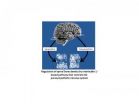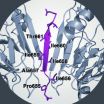(Press-News.org) RUB-Researchers from the Chair for Biophysics have developed a new method for the detailed study of the interaction between pharmaceuticals and their target proteins. The pharmaceutical industry has already taken notice of the new infrared spectroscopy technique; the method is supposed to be implemented to investigate pharmacological agent-protein interactions in the EU project K4DD, which is supported by various major European pharmaceutical companies. "We now have a tool in our hands with which we can research the dynamics of pharmacologically interesting proteins in atomic detail," Prof. Dr. Klaus Gerwert said. "We want to undertake a targeted screening of substance libraries to look for potential pharmacological agents." PD Dr. Carsten Kötting added that "with our technique future pharmaceuticals can be more closely tailored to illness-causing proteins, which can noticeably reduce the negative side effects of these drugs." They described the new method together with Dr. Jörn Güldenhaupt and Philipp Pinkerneil in the scientific journal ChemPhysChem, which dedicated its cover story to this topic.
The new method: from three to one
With infrared difference spectroscopy, researchers follow dynamic processes in proteins. For a long time, these processes could only be observed in light-activated proteins, but not in proteins that are activated by binding with ligands – but this is usually how many illness relevant molecules are activated. To analyze the dynamics of such proteins, researchers have to fasten them to the measurement surface and pour a pharmacological-substance over them; the proteins can then interact with and be activated by this substance. Even though this binding technique is possible, it cannot be used for all proteins. The RUB-Team worked around this problem by combining infrared (IR) spectroscopy with a surface-sensitive technique (attenuated total reflectance) and so-called "His-Tagging" (anchoring proteins to the measurement surface).
Attenuated total reflectance: bringing the infrared beam to all proteins
In conventional IR spectroscopy, an infrared beam is passed through a liquid sample; part of the light is absorbed by the proteins, which allows researchers to draw conclusions about their structure. The RUB-researchers beamed the infrared light through a germanium crystal, on whose surface proteins were anchored. At the boundaries of the crystal the light is reflected over and over, thereby spreading throughout the crystal (attenuated total reflectance). During this process, some of the light waves leave the crystal and reach the proteins that are fastened to its surface. A similar technique, the Surface Plasmon Resonance, is the standard for use in the pharmaceutical industry, but does not have the atomic resolution capabilities of the new technique.
Part of the chain: the His-Tag
This bonding of the proteins to the crystal succeeds through usage of the His-Tag, a simple amino acid chain, which is commonly attached to proteins today to enable their biochemical study – it is essentially a universal adapter. Through the His-Tag the RUB-researchers were able to anchor the protein to the germanium crystal. As a result the molecules were firmly bound to the measurement surface, which transmits the infrared light to the proteins by the process of attenuated total reflectance. The big advantage: an abundance of proteins are already fitted with the His-Tag; therefore examining them with the new method is unproblematic. All other proteins to which a His-Tag is attached can now also be accessed by IR spectroscopy. "This will help answer a multitude of biological and medical questions," Gerwert said.
Establishment of the new method with the switch protein Ras
The RUB-Team first tried their new method on the switch protein Ras, the central on/off switch for cell growth. Defect, or oncogenic Ras, is one of the cells most frequently responsible for causing cancer. The researchers succeeded in fastening Ras to the measurement surface with the His-Tag, and then activating the Ras by binding it to a ligand. "The technique is so sensitive that we could resolve the signal of a five nanometer thick protein layer. That's about 1/10000 of the diameter of a human hair," RUB-researcher Dr. Jörn Güldenhaupt, who contributed significantly to the development of the new method, said. Even the smallest structural changes during the Ras protein's switch from its "on" to its "off" state were recognized with the "protein-nanoscope."
###
Project funding
Funding for the project came from the Protein Research Department at the RUB, from the state of NRW in the framework of the Center for Vibrational Microscopy (CVM) and from the SFB 642, "GTP and ATP Dependent Membrane Processes," whose speaker is Prof. Gerwert.
Bibliographic record
P. Pinkerneil, J. Güldenhaupt, K. Gerwert, C. Kötting (2012): Surface-attached polyhistidine-tag proteins characterized by FTIR difference spectroscopy, ChemPhysChem, doi: 10.1002/cphc.201200358
Figure online
A figure illustrating the new method can be downloaded from the following website:
http://aktuell.ruhr-uni-bochum.de/pm2012/pm00284.html.en
Further Information
Prof. Dr. Klaus Gerwert, Chair for Biophysics, Faculty for Biology and Biotechnology at the Ruhr-Universität, 44780 Bochum, Germany, Phone:
+49/234/32-24461
klaus.gerwert@bph.ruhr-uni-bochum.de
Click for more
Biophysics at RUB
http://www.bph.ruhr-uni-bochum.de/index_en.htm
Full text article
http://onlinelibrary.wiley.com/doi/10.1002/cphc.201200358/full
Editorial Journalists: Charlotte Ziob/Julia Weiler
New infrared spectroscopy technique
Interaction between proteins and pharmaceuticals can now be analyzed in detail
2012-09-04
ELSE PRESS RELEASES FROM THIS DATE:
New neural pathway controlling skeletal development discovered
2012-09-04
Jerusalem, Sept. 3, 2012 – Researchers at the Hebrew University of Jerusalem have discovered that a neuronal pathway -- part of the autonomic nervous system -- reaches the bones and participates in the control of bone development.
The newly discovered pathway has a key role in controlling bone density during adolescence, which in turn determines the skeletal resistance to fracture throughout one's entire life, say the researchers. They emphasize that understanding the mechanisms connecting the brain and the bones could have implications for possible future therapies ...
Broader approach provides new insight into diabetes genes
2012-09-04
Using a new method, diabetes researchers at Lund University, Sweden, have been able to reveal more of the genetic complexity behind type 2 diabetes. The new research findings have been achieved as a result of access to human insulin-producing cells from deceased donors and by not only studying one gene variant, but many genes and how they influence the level of the gene in pancreatic islets and their effect on insulin secretion and glucose control of the donor.
"With this approach, we can explain 25 per cent of variations in blood sugar levels. Previously, the best studies ...
New ESF-cofunded feasibility study calls for a single European researcher development framework
2012-09-04
The aim of the study was to assess the applicability across Europe of a generic framework for the professional development of researchers based on the Vitae Researcher Development Framework (RDF). The RDF is a UK-context framework set up with the purpose to better define researcher's professional profiles and to develop guidance for the continuous professional development of researchers. The report reveals that there is a real demand among researchers for a more structured approach towards researcher´s professional development and active career planning.
This new ESF-co-funded ...
Anchoring proteins influence glucose metabolism and insulin release
2012-09-04
HEIDELBERG, 3 September 2012 – Scientists from the United States and Sweden have discovered a new control point that could be important as a drug target for the treatment of diabetes and other metabolic diseases. A-kinase anchoring proteins or AKAPs are known to influence the spatial distribution of kinases within the cell, crucial enzymes that control important molecular events related to the regulation of glucose levels in the blood. In a new study published in The EMBO Journal, the team of researchers led by Simon Hinke and John Scott reveal for the first time that AKAPs ...
PharmaNet system dramatically reduced inappropriate prescriptions of potentially addictive drugs
2012-09-04
A centralized prescription network providing real-time information to pharmacists in British Columbia, Canada, resulted in dramatic reductions in inappropriate prescriptions for opioid analgesics and benzodiazepines, widely used and potentially addictive drugs. The findings are reported in a study in CMAJ (Canadian Medical Association Journal).
The study found that PharmaNet, a real-time prescription system implemented in BC pharmacies in July 1995, reduced potentially inappropriate prescriptions for opioids and benzodiazepines in two groups of patients — those on social ...
Canada should remove section of Criminal Code that permits physical punishment of children
2012-09-04
To promote good parenting, Canada should remove section 43 of its Criminal Code because it sends the wrong message that using physical punishment to discipline children is acceptable, argues Dr. John Fletcher, Editor-in-Chief, CMAJ (Canadian Medical Association Journal) in an editorial.
Section 43 of the Criminal Code of Canada states "…a parent is justified in using force by way of correction…if the force does not exceed what is reasonable under the circumstances."
The debate over whether spanking children is acceptable as a disciplinary tool for parents or whether ...
Ovarian cancer cells hijack surrounding tissues to enhance tumor growth
2012-09-04
Tumor growth is dependent on interactions between cancer cells and adjacent normal tissue, or stroma. Stromal cells can stimulate the growth of tumor cells; however it is unclear if tumor cells can influence the stroma. In the September issue of the Journal of Clinical Investigation, researchers at MD Anderson Cancer Center report that ovarian cancer cells activate the HOXA9 gene to compel stromal cells to create an environment that supports tumor growth.
Honami Naora and colleagues found that expression of HOXA9 was correlated with poor outcomes in cancer patients and ...
JCI early table of contents for Sept. 4, 2012
2012-09-04
Ovarian cancer cells hijack surrounding tissues to enhance tumor growth
Tumor growth is dependent on interactions between cancer cells and adjacent normal tissue, or stroma. Stromal cells can stimulate the growth of tumor cells; however it is unclear if tumor cells can influence the stroma. In this issue of the Journal of Clinical Investigation, researchers at MD Anderson Cancer Center report that ovarian cancer cells activate the HOXA9 gene to compel stromal cells to create an environment that supports tumor growth.
Honami Naora and colleagues found that expression ...
EARTH: Antarctic trees surprise scientists
2012-09-04
Alexandria, VA – "Warm" and "Antarctica" are not commonly used in the same sentence; however, for scientists, "warm" is a relative term. A team of researchers has discovered that, contrary to previous thinking, the Antarctic continent has experienced periods of warmth since the onset of its most recent glaciation.
Lodged in ocean sediment nearly 20 million years old, ancient pollen and leaf wax samples taken from the Ross Ice Shelf suggest that two brief warming spells, each of which lasted less than 30,000 years, punctuated the omnipresent cold of Antarctica. Warm, ...
Binding sites for LIN28 protein found in thousands of human genes
2012-09-04
A study led by researchers at the UC San Diego Stem Cell Research program and funded by the California Institute for Regenerative Medicine (CIRM) looks at an important RNA binding protein called LIN28, which is implicated in pluripotency and reprogramming as well as in cancer and other diseases. According to the researchers, their study – published in the September 6 online issue of Molecular Cell – will change how scientists view this protein and its impact on human disease.
Studying embryonic stem cells and somatic cells stably expressing LIN28, the researchers defined ...
LAST 30 PRESS RELEASES:
Making lighter work of calculating fluid and heat flow
Normalizing blood sugar can halve heart attack risk
Lowering blood sugar cuts heart attack risk in people with prediabetes
Study links genetic variants to risk of blinding eye disease in premature infants
Non-opioid ‘pain sponge’ therapy halts cartilage degeneration and relieves chronic pain
AI can pick up cultural values by mimicking how kids learn
China’s ecological redlines offer fast track to 30 x 30 global conservation goal
Invisible indoor threats: emerging household contaminants and their growing risks to human health
Adding antibody treatment to chemo boosts outcomes for children with rare cancer
Germline pathogenic variants among women without a history of breast cancer
Tanning beds triple melanoma risk, potentially causing broad DNA damage
Unique bond identified as key to viral infection speed
Indoor tanning makes youthful skin much older on a genetic level
Mouse model sheds new light on the causes and potential solutions to human GI problems linked to muscular dystrophy
The Journal of Nuclear Medicine ahead-of-print tip sheet: December 12, 2025
Smarter tools for peering into the microscopic world
Applications open for funding to conduct research in the Kinsey Institute archives
Global measure underestimates the severity of food insecurity
Child survivors of critical illness are missing out on timely follow up care
Risk-based vs annual breast cancer screening / the WISDOM randomized clinical trial
University of Toronto launches Electric Vehicle Innovation Ontario to accelerate advanced EV technologies and build Canada’s innovation advantage
Early relapse predicts poor outcomes in aggressive blood cancer
American College of Lifestyle Medicine applauds two CMS models aligned with lifestyle medicine practice and reimbursement
Clinical trial finds cannabis use not a barrier to quitting nicotine vaping
Supplemental nutrition assistance program policies and food insecurity
Switching immune cells to “night mode” could limit damage after a heart attack, study suggests
URI-based Global RIghts Project report spotlights continued troubling trends in worldwide inhumane treatment
Neutrophils are less aggressive at night, explaining why nighttime heart attacks cause less damage than daytime events
Menopausal hormone therapy may not pose breast cancer risk for women with BRCA mutations
Mobile health tool may improve quality of life for adolescent and young adult breast cancer survivors
[Press-News.org] New infrared spectroscopy techniqueInteraction between proteins and pharmaceuticals can now be analyzed in detail


